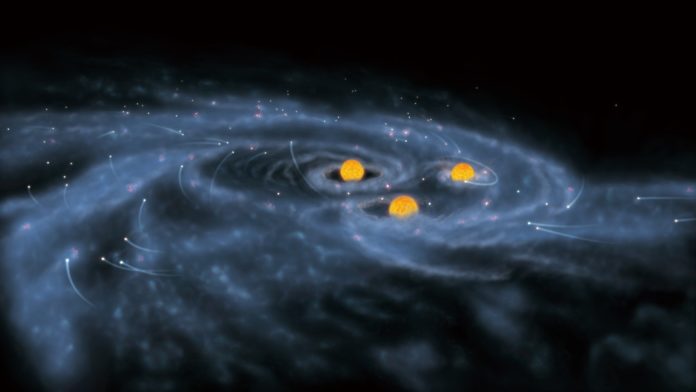A new study set out to disclose a new theory of the origin of the black holes. Astrophysicists at Tohoku University conducted computer simulations and revealed that the precursors of supermassive black holes grow by swallowing up not only interstellar gas, but also smaller stars as well.
The origin of the black holes remains obscure. According to a theory, the direct collapse model where primordial clouds of interstellar gas collapse under self-gravity to form supermassive stars which then evolve into supermassive black holes.
But, past studies have had suggested that direct collapse only works with pristine gas consisting of only hydrogen and helium. Heavier elements such as carbon and oxygen change the gas dynamics, causing the collapsing gas to fragment into many smaller clouds which form small stars of their own, rather than a few supermassive stars. Direct collapse from pristine gas alone can’t explain the large number of supermassive black holes seen today.
This new study, using National Astronomical Observatory of Japan’s supercomputer “ATERUI II”, performed high-resolution simulations to test the probability that supermassive stars could form even in heavy-element-enriched gas. Scientists found that supermassive stars can still form from heavy-element enriched gas clouds.
True to form, the gas cloud separates violently and numerous small stars form. Be that as it may, there is a strong gas flow towards the center of the cloud; the small stars are hauled by this stream and are gobbled up by the supermassive stars in the inside. The simulations brought about the formation of a huge star 10,000 times more huge than the Sun.
Sunmyon Chon, a postdoctoral fellow at the Japan Society for the Promotion of Science and Tohoku University said, “This is the first time that we have shown the formation of such a large black hole precursor in clouds enriched in heavy-elements. We believe that the giant star thus formed will continue to grow and evolve into a giant black hole.”
Kazuyuki Omukai, a professor at Tohoku University said, “This new model shows that not only primordial gas, but also gas containing heavy elements can form giant stars, which are the seeds of black holes. Our new model is able to explain the origin of more black holes than the previous studies, and this result leads to a unified understanding of the origin of supermassive black holes.”
Journal Reference:
- Sunmyon Chon et al., Supermassive star formation via super competitive accretion in slightly metal-enriched clouds. DOI: 10.1093/mnras/staa863
